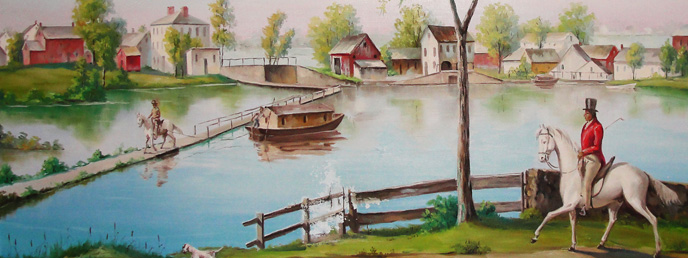


Middlesex Canal Association P.O. Box 333 Billerica, Massachusetts 01821
www.middlesexcanal.org
| Volume 58 No. 3 | April 2020 |
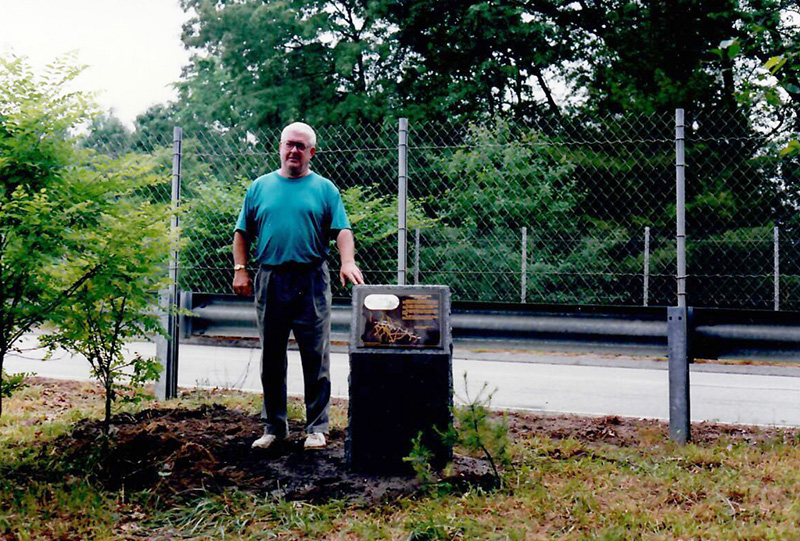
John Reardon is pictured here standing beside the Middlesex Canal Commission wayside marker on High Street in North Billerica. The site was rededicated in 2016 with funds obtained by the Billerica Historical Commission from EMD Serono coupled with additional money from the Middlesex Canal Association and private donations private donations. The Middlesex Canal Commission: Billerica Section has been maintaining the site for the past four years.
Unfortunately, the lawn care company employed to upkeep the site has sold the business and the new company has no interest in maintaining the site. If any of our readers know of anyone interested in maintaining the site would they please contact the Billerica Section at ingrahamalec@gmail.com.
Please mark your calendars
MCA Sponsored Events
2020 Schedule
Spring Meeting, 1:00pm, Sunday, May 3, 2020
“The History, Development, Operation, and Economic Impact of Early Canals in England” by Bill Gerber
Due to the Pandemic caused by the COVID-19 Virus this meeting will be held virtually.
Information on how to access the meeting remotely will be posted on the MCA website.
Special Event – “Walk with Thoreau Along the Middlesex Canal”
10:00am, Saturday, June 20, 2020
Leader: Marlies Henderson
Special Event – “Middlesex Village Walk”
10:00am - 11:30am, Saturday, June 27, 2020
Leader: Dick Howe
18th Annual Bike Tour, North, 9:00am, Saturday, October 3, 2020
Fall Walk, 1:30pm, Sunday, October 18, 2020
Wilmington Town Park to Patch’s Pond
Fall Meeting, 1:00pm, Sunday, October 25, 2020 Speaker TBA
The Visitors Center/ Museum is open Saturday and Sunday, Noon – 4:00 P.M., except on a holiday (April 12, 2020 Easter). The Board of Directors meets the 1st Wednesday of each month, 3:30-5:30 P.M., except July and August. Check the MCA website for updated information during the COVID-19 pandemic.
Visit www.middlesexcanal.org for up-to-date listings of MCA events and other events of interest to canallers!
TABLE OF CONTENTS
MCA Sponsored Events and Directions to Museum
President’s Message by J. Jeremiah Breen
Winter Meeting Report by Debra Fox
Excerpt from Loammi Baldwin’s Diary on April 17, 1775 published in History of Middlesex County, Vol. 1, p447, Hurd, submitted by Howard Winkler
“High Street Skinny Dippers” by Marlies Henderson
“The Bridge at the Falls” by Alec Ingraham
“The Smallpox Cemetery” by Alec Ingraham
Editors’ Letter
April, 2020
What a different world since the last issue! We hope this one finds you safe and well and ready for interesting reading.
First things first; we are still listing the May 3rd annual meeting and lecture but it most likely will have to be cancelled and rescheduled, so watch for emails or check the MCA website. Hopefully, the October events will go as planned.
In case you were not able to attend, the issue begins with Deb’s report of the Winter Meeting. Due to the distractions of the virus crisis, we received only two short articles, one an excerpt from Loammi Baldwin’s diary submitted by Howard Winker, and, the second, an interesting essay, “High Street Skinny Dipping,” by Marlies Henderson. In the spirit of providing more content and getting the edition out on time, Alec reached into his file cabinet and provided two items about North Billerica for your edification. The first is a history of the Faulkner Street Bridge, including historic photos. The second article is about the smallpox outbreak of 1811. Those of you who had planned to go on the smallpox cemetery walk can take a “virtual tour” back to 1811. This will be a two-part story and if anything will show that things do change but some things always are the same.
Please Enjoy! Deb Fox, Alec Ingraham, Robert Winters
MCA Sponsored Events and Directions to Museum
Spring Meeting (Annual Meeting): On May 3, 2020, the MCA will hold a Virtual Meeting at 1:00pm. Instructions on how to attend the meeting on a computer or smart phone are posted on the MCA website, www.middlesexcanal.org. Howard Winkler will act as the host.
Following a short business meeting, Bill Gerber, past MCA President, will be the keynote speaker. In the early 1980’s, British Canal Enthusiasts conducted a week long course on the history, development, operation, and economic impact of their early canals, a resource that, in recent years, they have restored and now enjoy as a recreational amenity. Bill will revisit some of the key points and issues presented during that week, and a subsequent trip along the Grand Union Canal.
Special Event: Walk with Thoreau Along the Middlesex Canal: Join experienced guide Marlies Henderson to explore extant sections of the Middlesex Canal, reading passages from Henry David Thoreau describing the towpath, from the Billerica Falls to Middlesex Village. Meet at the gazebo at the falls in North Billerica at 10:00am on Saturday, June 20, 2020, for an easy 3-hour walk. High boots are recommended.
Special Event: Middlesex Village Walk: The walk will be led by Lowell historian, Dick Howe. Participants should meet at Hadley Field at the corner of Baldwin and Middlesex Streets in Lowell at 10:00am on Saturday, June 27, 2020. This one-and-a-half-hour event is sponsored by Lowell Walks in conjunction with the Lowell National Historical Park.
18th Annual Bike Tour North: On Saturday, October 3, 2020, riders are encouraged to meet at 9:00am at the Middlesex Canal plaque, Sullivan Square MBTA Station (1 Cambridge Street, Charlestown, MA 02019). The ride will follow the canal route for 38 miles to Lowell. There will be stops for snacks at the Kiwanis Park across from the Baldwin mansion (2 Alfred Street, Woburn, MA 01801 ~ 12:30pm) and for a visit to the Middlesex Canal Museum (71 Faulkner Street, North Billerica, MA 01862). The tour will arrive in Lowell in time for the 5:30pm train back to Boston. Riders are able to choose their own time to join or leave the tour by using the Lowell line which parallels the canal. The ride is easy for most cyclists. The route is pretty flat and the tour group will average about 5 MPH. Steady rain cancels; helmets are required. For changes and updates see www.middlesexcanal.org. It is anticipated that the tour will be led by Bill Kuttner and Dick Bauer.
Fall Walk: The MCA, in conjunction with the Appalachian Mountain Club, will sponsor a canal walk on October 18, 2020 at 1:30pm. Participants are encouraged to meet at the Wilmington Town Park across from 760 Main Street (Rte. 38). Points of interest, along the 8/10 of a mile Middlesex Canal route, will include the Ox Bow Turn where striations from the tow ropes are imbedded in the ledge along the canal, the signs of Fall as the trek continues through the 14-acre tract gifted to the MCA by Stanley Webber and his daughter, Julia Ann Fielding, and finally Patches Pond. MCA member, Robert Winters will lead the walk. Additional information is available at www.middlesexcanal.org.
Directions to Museum: 71 Faulkner Street in North Billerica MA.
By Car
From Rte. 128/95
Take Route 3 toward Nashua, to Exit 28 “Treble Cove Road, North Billerica, Carlisle”. At the end of the ramp, turn left onto Treble Cove Road toward North Billerica. At about ¾ mile, bear left at the fork. After another ¼ mile, at the traffic light, cross straight over Route 3A (Boston Road). Go about ¼ mile to a 3-way fork; take the middle road (Talbot Avenue) which will put St. Andrew’s Church on your left. Go ¼ mile to a stop sign and bear right onto Old Elm Street. Go about ¼ mile to the bridge over the Concord River, where Old Elm Street becomes Faulkner Street; the Museum is on your left and you can park across the street on your right, just beyond bridge. Watch out crossing the street!
From I-495
Take Exit 37, North Billerica, then south roughly 2 plus miles to the stop sign at Mt. Pleasant Street, turn right, then bear right at the Y, go 700’ and turn left into the parking lot. The Museum is across the street (Faulkner Street).
By Train
The Lowell Commuter line runs between Lowell and Boston’s North Station. From the station side of the tracks at North Billerica, the Museum is a 3-minute walk down Station Street and Faulkner Street on the right side.
President’s Message - “Community Preservation”
by J. Breen
Lowell voters approved in November a 1% surcharge on their property taxes to fund projects approved by a Community Preservation Committee. The 1% is expected to amount to $700,000± in 2020. The Commonwealth’s $50 community preservation surcharge on most documents recorded at the registry of deeds is likely to add >$160,000 to the amount. Billerica town meeting in 2018 granted the Association the $100,000 approved by the Billerica CPC for the Middlesex Canal Visitor Center/Museum project. What follows are ideas for projects in Lowell.
Before the railroad transformed transportation, efficient transportation was by boat. A horse and wagon could haul two tons, a horse and canal boat, twenty tons, a ten-to-one advantage Before the railroad was built from Boston Harbor to Lowell in 1835, bales of cotton were shipped to Lowell for more than twenty years in canal boats. The center of Lowell for its first twenty years was the intersection of Central and Market Streets where the canal boat landing was. The existing Canal Way sign at what was the City Landing, now a plaza between Align Credit Union, 40 Market Street, in the old market building, and the Pawtucket Canal, should be replaced by a sign describing the history of the location in the beginning of Lowell. Not a preservation project as much as a recovery of the community’s beginning at a side landing on the water highway between Boston Harbor and Concord, located where there was bridge over the Pawtucket Canal, a bridge over the Concord River, and a ferry crossing the Merrimack River.
A railroad locomotive is on exhibition aside the Merrimack Canal where Merrimack Street crosses, the site in 1835 of the first depot. Two quotes from the exhibit,
1. “In pre-railroad Lowell, the most valuable industrial sites were on the canals, where mills took advantage of the maximum waterpower. The new railroad soon built spur lines to the mills, establishing a fan-shaped net over the mill district.” The spur lines replaced the canal boats which delivered bales of cotton to a storehouse built over the canals at the mills.
2. “The continuing prosperity of industrial Lowell depended on efficient shipping of materials.” The founding document of Lowell was the 1821 Articles of Association of the Merrimack Manufacturing Company. Pre-railroad, and pre-Lowell, efficient shipping was the one-horse canal boat on the Middlesex Canal, completed in 1803.
The locomotive exhibit is in Lowell because the Boston and Maine Historical Society is in Lowell. Lowell is where Lowell is because the Middlesex Canal made it possible to compete with other mill towns with efficient water transportation, e.g., Dover NH’s 1816 cotton factory. Given the importance of transportation to the founding of Lowell, a canal boat aside the Merrimack Canal that supplied the first mill with power and cotton is more apt than a locomotive. A canal boat exhibit describing the water highway between Boston and the mill is a project appropriate for preserving community history.
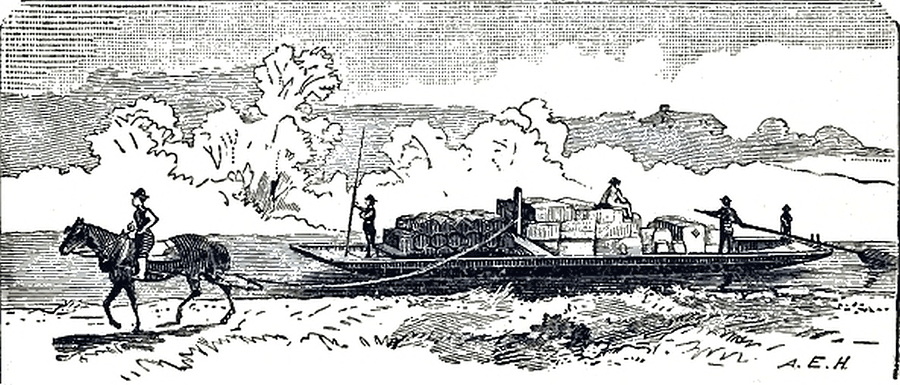
The Towpath by Allan Evans Herrick
The canal boat had a ten-to-one advantage over the wagon. The liquidation of the Middlesex Canal can be described succinctly as the one- horse canal boat quickly losing to the first iron horse of the Boston and Lowell Railroad, the Stephenson, rated 30 horsepower, a thirty-to-one advantage.
An excellent project for Lowell’s 1% Community Preservation funds would be a wayside exhibit on the Massachusetts Dept. of Conservation and Recreation’s Vandenberg Esplanade. On the Esplanade is a memorial to Scott Finneral, 200’ south of the UMass Lowell Bellegarde boathouse. Below is a photo of the memorial with a white marker on the south bank, the approx. location of the canal. Directly across the Merrimack from the memorial is a railroad culvert visible when the leaves have fallen. The culvert and its significance are described in “Locks in Lowell”, Towpath Topics, Vol. 54, No. 1.
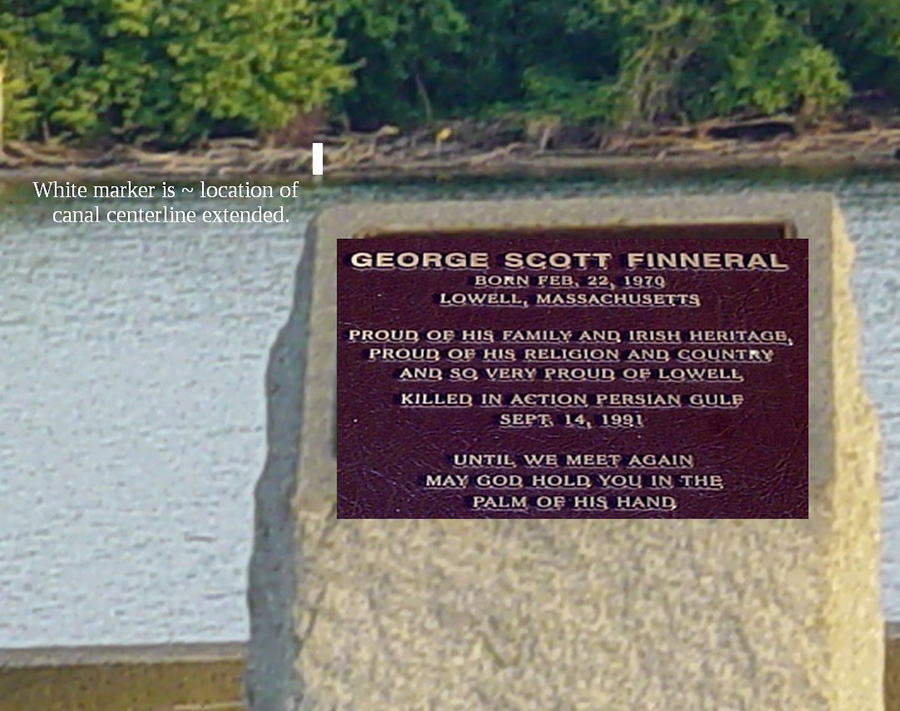
At this spot on the Vandenberg Esplanade opposite the culvert, the Middlesex Canal Association would have a wayside exhibit describing the (1) Middlesex Canal, “the greatest work . . . completed in the United States”;1 (2) the spot where Henry Thoreau took his nooning among the apple trees opposite the glass works after boating from the Concord River to the Merrimack;2 and (3) the establishment with the opening of the canal in 1803 of a glassworks using sand from New Jersey and wood from New Hampshire. The major image of the wayside exhibit could be the Mt. Vesuvius of the glassworks as the sand was melted at 2100°F and kept at 2100° day and night burning wood from the forests of New Hampshire, a hellish working environment for German glass blowers,3 needing an Hieronymus Bosch to paint it. Or the watercolor, Middlesex Village, Dahill, 1996.
Footnotes:
1. Albert Gallatin, Report of the Secretary of the Treasury; on the Subject of Public Roads and Canals; made in pursuance of a Resolution of the Senate, of March 2, 1807 (Washington: R.C. Weightman, 1808). Retrieved from the internet, http://oll.libertyfund.org/titles/2046.
2. Thoreau Towpath in “President’s Message”, Towpath Topics, Vol. 50, No. 2.
3. German Glass Blowers in Chelmsford by Dorit Lammers, 2005.
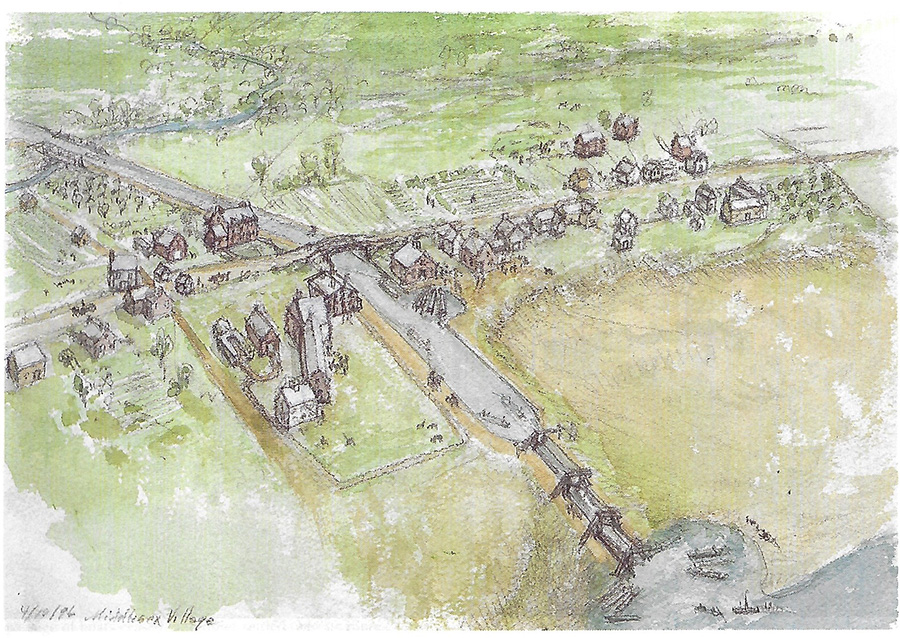
Middlesex Village, Dahill, 1996, from an 1829 survey. The village developed after the canal opened in 1803.
Boats traveling between Boston and Concord NH used the three lock staircase to move between the canal and the Merrimack River, 24’ lower.
Notes.
A. Middlesex Village Walk, Saturday, June 27 @ 10:00am-11:30am. Led by Dick Howe. Meet at Hadley Field, corner of Baldwin and Middlesex Streets. Lowell Walks in partnership with Lowell National Historical Park. http://richardhowe.com/2020/02/23/lowell-walks-2020-schedule/
B. Paul Tsongas chose the location on the Merrimack River for the bronze plaque, so said Scotty’s mother. The family has a memorial on Lincoln Avenue.
C. Baldwin’s 1830 profile, (107.50’ miter sill + 3½’ design depth) - 89.45 Water of River = 18.05’ lift after Pawtucket Dam raised in 1826. Weston in 1794 reported 24’ 6” between Concord and Merrimack Rivers.
D. For location of Lowell, “President’s Message”, Towpath Topics, Vol. 53, No.2.
E. NPS Wayside Exhibits, a guide to developing outdoor interpretive exhibits.
 Alison Field-Juma, February 9, 2020 |
MCA Winter Meeting Report
by Debra Fox
On February 9th at 2pm in the Reardon Room of the Faulkner Mill, the Middlesex Canal Association held the Winter Meeting and hosted Alison Field-Juma, director of OARS, a non-profit watershed organization.
The room was filled with over 30 attendees as she presented the results of her organization’s assessment of the Sudbury, Assabet, and Concord Rivers. The results of assessments are collected into a “report card” and a grade is given. The reasons for the grade were broken down according to categories, such a recreational use, cultural assets, access, diversity of life (in the water like fish, birds, turtles, etc.). Then, the sections of the river were also graded, and Ms. Field-Juma explained which areas had problems and what caused those problems.
While the overall watershed area grade was a “B,” and this was a respectable grade, there were sections that were still polluted by factory run-off (Southborough) and acid rain from Pennsylvania. All this information was outlined and described very clearly in the Power Point presentation.
The question of dam removal was the underlying topic, however. The effects of removal would be felt throughout the entire watershed area and will not be settled without more discussion, but this was an interesting and well-done presentation on the condition of this watershed area.
Most visitors remained to ask questions and refreshments were made available in the back of the room. Everyone left feeling full of knowledge and food!
From Howard Winkler:
In my research for an article I was writing for the Arlington Historical Society, I found a page from the diary of Loammi Baldwin dated April 19, 1775, in We Were Th
ere!, April 19, 1775, Complied by Vincent Jeffre-Roux Kehoe, c.1974, vol 2., p.13.
To those Men whose HONOR places MILITARY DUTY and DEVOTION to their Country before personal gain or political expediency. A collection of all known depositions, diaries, accounts, reports, orders, and recollections of the most famous “Longest day” in the American War for Independence from the view of the British soldier and American rebel told from their actual words.
Loammi Baldwin’s Diary for April 19, 1775 (Loammi Baldwin was a major in the Woburn militia when he led them on April 19, 1775. He was soon commissioned colonel.)
“1775, April 19, Wednesday. This morning a little before the break of day, we were alarmed by Mr. Steadman’s Express from Cambridge. Informed us that the Regulars were on the move for Concord. We mustered as fast as possible. The town turned out extraordinary, and proceeded toward Lexington. I rode along a little before the main body, and, when I was neigh, Jacob Reed’s I heard great firing; proceeded on, -- soon heard that the Regulars had fired upon Lexington people and killed a large number of them. We proceeded on as fast as possible and came to Lexington and saw 8 or 10 dead and members wounded . . . . We proceeded to Concord by way of Lincoln meeting-house, . . . ascended the hill and pitched and refreshed ourselves a little. The people under my command and some others came running off the East end of the hill while I was at a house - - and we proceeded down the road and could see behind us the Regulars following. We came to Tanner Brook, at Lincoln Bridge, and then concluded to scatter and make use of trees and walls for to defend us, and attack them. We did so and pursued on, flanging them (Mr. Daniel Thompson was killed, and others,) till we came to Lexington. I had several good shots. The enemy marched very fast and left behind many dead and wounded and a few tired. I proceeded on till coming between the meeting-house and Buckman’s Tavern with a prisoner before me, when the cannon began to play, the balls flew near me. I judged not more than 2 yards off. I immediately retreated back behind the meeting house, and had not been there ten seconds before a ball came through the meeting-house near my head. I retreated back towards the meadow, north of the meeting-house, and lay and heard the balls in the air and saw them strike the ground.”
From: History of Middlesex County, vol. I, p. 447 (Hurd)
High Street Skinny Dippers
by Marlies Henderson
The 2019 Corona Virus brought the Hike Beautiful Billerica weekly winter walks movement to an abrupt halt, canceling its last scheduled hike, as well as the March 22 Middlesex Canal Spring Walk. The winter walkers did visit the Small Pox cemetery on March 7. Participants met near the Middlesex Canal Museum & Visitor Center for a group portrait in front of the future museum after which all enjoyed a two hour walk along sections of the canal and a portion of Mansfield’s 1877 Narrow Gauge railroad:
“Between Billerica and North Billerica, there would be only one significant bridge, the 80-foot trestle over the old Middlesex Canal. Although there had been no real use of the canal since the arrival of the Boston & Lowell Railroad, some flatboats loaded with sand came along the channel so the bridge had to be high enough for those to clear.” 1
The bridge has been replaced by a B&M track, the canal is filled in, but the track is no longer actively used.
On the way to the Small Pox cemetery, walkers use the berm side of the canal, and also the towpath on the other side. Where the canal intersects High Street is an interpretive marker:
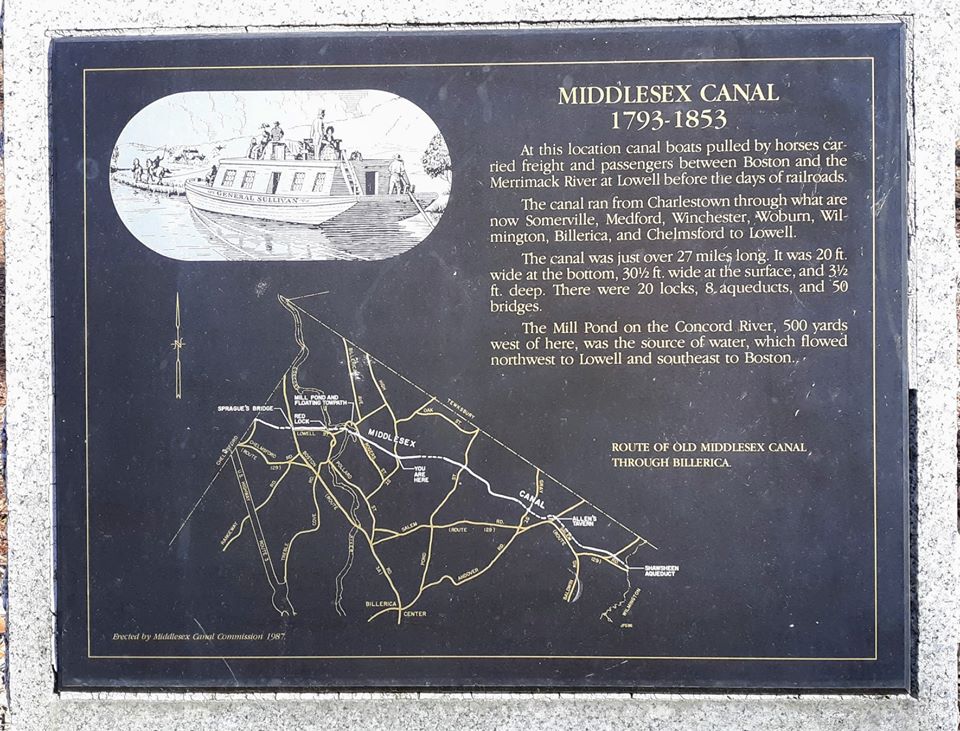
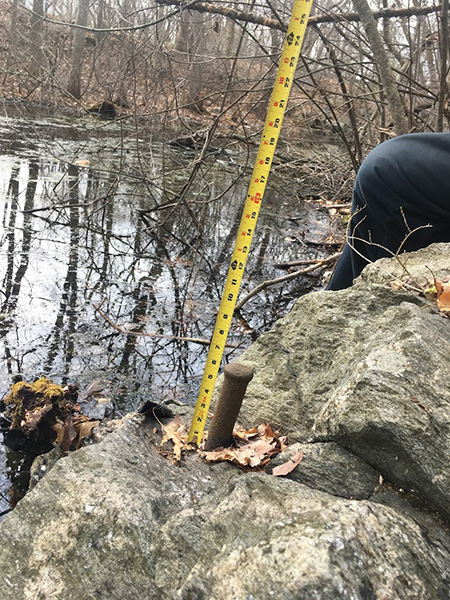 “MIDDLESEX CANAL”
“MIDDLESEX CANAL”
1793-1853
“At this location canal boats pulled by horses carried freight and passengers between Boston and the Merrimack River at Lowell before the days of railroads. The canal ran from Charlestown through what are now Somerville, Medford, Winchester, Woburn, Wilmington, Billerica, and Chelmsford to Lowell. The canal was just over 27 miles long. It was 20 ft. wide at the bottom, 30½ ft. wide at the surface, and 3½ ft. deep. There were 20 locks, 8 aqueducts, and 50 bridges. The Mill Pond on the Concord River, 500 yards west from here, was the source of water, which flowed northwest to Lowell and southeast to Boston.”
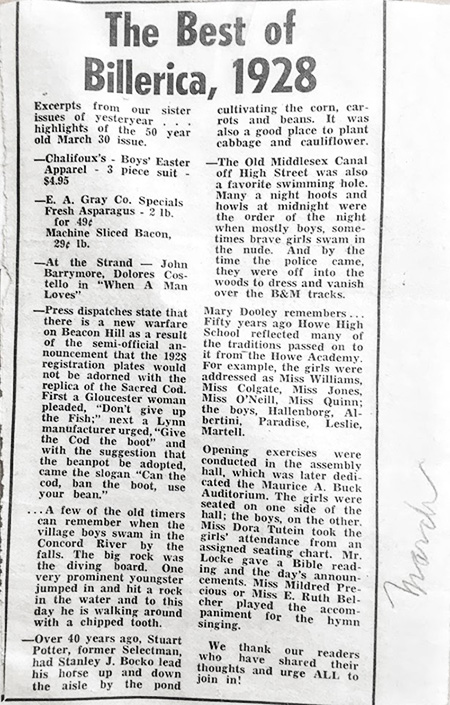 Of the twenty locks, the Lincoln Lock was south of the Summit Pond (the Concord River being the source for both the northern and southern canal sections), and there was a lock at the Talbot Mill site. From the latter the lock hinge and a hitching pin remain, and recently J. Jeremiah Breen and myself discovered a similar hitching pin at the site of the Lincoln Lock. Note that the William Rogers House on 18 Rogers Street faces the canal; the main highway when the house was built (1807).2
Of the twenty locks, the Lincoln Lock was south of the Summit Pond (the Concord River being the source for both the northern and southern canal sections), and there was a lock at the Talbot Mill site. From the latter the lock hinge and a hitching pin remain, and recently J. Jeremiah Breen and myself discovered a similar hitching pin at the site of the Lincoln Lock. Note that the William Rogers House on 18 Rogers Street faces the canal; the main highway when the house was built (1807).2
Back to High Street: Mr. Alec Ingraham recalls skating on the canal: “That section of the canal was one of the first bodies of water in the north part of town to freeze solid enough for skating. We used to play ice hockey and enjoyed racing on the strait away from High Street to the old railroad track. It was a wonderful experience gliding along, an experience not afforded by a circular rink.”
Mr. Alec Ingraham added, “Of course it was not plowed in the winter so we had a limited time when the skating was possible. Most of the winter though we ice skated a Potter’s Pond behind the house [Mt. Pleasant Street]. It was cleared of snow.” Obviously, the climate has since changed, and we can no longer take snow and ice for granted.
A March 30, 1978 newspaper clipping celebrating a 50th anniversary quoted “The Best of Billerica, 1928 […] Excerpts from our sister issues of yesteryear3 … highlights of the 50 year old March 30 issue […]
“–The Old Middlesex canal off High Street was also a favorite swimming hole. Many a night hoots and howls at midnight were the order of the night when mostly boys, sometimes brave girls swam in the nude. And by the time the police came, they were off into the woods to dress and vanish over the B&M tracks.”
The following image shows swimmers and divers in appropriate one-piece bathing attire finding refreshment on a hot day. Today it is the site of Billerica Iron Mountain, a records storage facility.
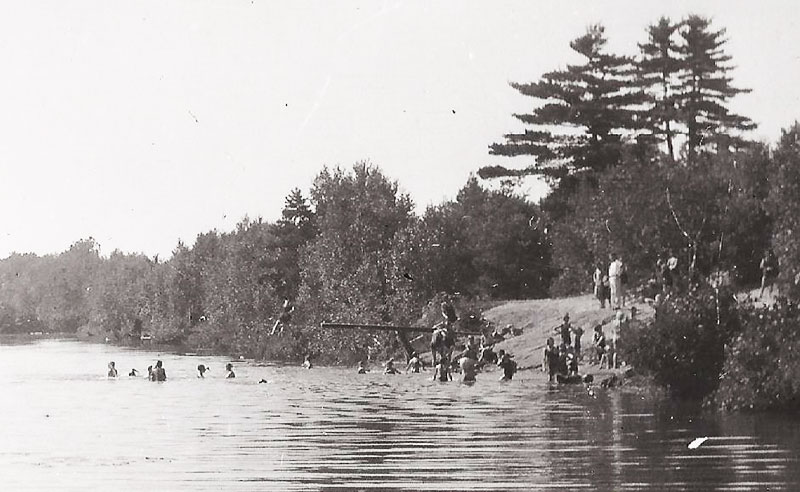
Alec Ingraham continued, “My mother once told me she used to swim in the canal off High Street, near the railroad overpass. She encountered what she believed to be a dead horse under the water. I’m not sure if that was the case but she would not allow us to swim there when we were kids. She also was concerned about the open pits left there as part of the remains from the Chemical Works.4 I often wondered what chemicals might have leached into the water in the canal. The police closed an illegal still in the remains of the Chemical Works during prohibition. I also know that a person who will remain nameless pushed a car frame into the water. The area has an interesting history.”
As for the chemicals; researching when the Chemical Works closed, I read the following: “The Talbot Dyewood & Chemical Company]’s principle products were sulphuric and muriatic acids, muriate of tin, salsoda, extract of indigo, nitric acid in varying strength, nitrate of iron, blue vitriol. The processes were complicated and interesting. Blue vitriol, for example, was made from scrap copper oxidized in a furnace. When the oxide was beaten off, the unoxidized pieces were returned for another beating. The oxide was digested with sulphuric [sic] acid, the resulting liquor drawn off into coolers where the vitriol was crystalized out on strips of lead, the beautiful blue crystals assuming very attractive shapes.”
The chemistry of the Middlesex Canal is made up of history and memories: Reminiscing chronologically, John Hancock signed (!) the act incorporating the proprietors of the Middlesex Canal in 1793. The charter required the canal to be completed within ten years. While it was operational from 1803 till 1853, Thoreau used it in 1839 (breaching many of its regulations), and Talbot established its Chemical Plants in 1849. The steam powered iron horse proved more efficient than the hay-fed ones or oxen, and after Loammi Baldwin had engineered the canal, his sons engineered a railroad beside it – active since 1835. After the Middlesex Canal Corporation sold land and water rights, the Massachusetts legislature declared the 1793 incorporation act for the canal forfeited and annulled in 1860. Then the Civil War occurred, America’s bloodiest and most divisive conflict; more than 620,000 people died. The earlier mentioned Narrow Gauge Bridge was built later, in 1877. Swimming and skating must have taken place since the canal was dug – until … I don’t know … until we were roused from our historical reveries!
I wish to conclude this story with hopes that it offers readers distraction from worldly cares during these unprecedented times of the CoViD-19 invasion.
Footnotes:
1. “George Mansfield and the Billerica and Bedford Railroad.” George Mansfield and the Billerica and Bedford Railroad, by Donald L. Ball, Aubrey Publications, 2011, p. 34.
2. MHC inventory no. BIL.128
3. The Billerica Minute-Man’s sister was The Billerica News (1928-1993).
4. Talbot Dyewood & Chemical Works, est. 1849, discontinued 1909 (from Warren H. Manning’s Billerica, Volume I, March, 1913, No. 10, page 11)
The Bridge at the Falls
by Alec Ingraham
In 1910, the Faulkner Street Bridge, which spanned the Concord River below the Talbot Mill dam in North Billerica, was in need of repair or replacement. Signs had been posted by the Selectmen that heavy trucking across the bridge was prohibited. The date of the first bridge at this location is not precisely known. A crude river crossing was probably erected around 1710 in conjunction with the grant awarded Christopher Osgood. In 1708 Christopher had received a grant of 40 acres of land on the west bank of the Concord River on the condition that he dam the river and operate a grist mill for the benefit of the citizens of Billerica. He was successful in meeting the terms of the grant and the dam at this location was completed by 1711. A map of the Town of Billerica prepared in 1794 by Samuel Whiting clearly shows a bridge at this location.
At this time the bridge at Faulkner Street had been in place for at least 20 years, but it is not clear when the bridge was actually erected. At the March 26, 1910 Billerica Town Meeting the Moderator was directed to appoint a committee to prepare plans and estimates for a new bridge across the Concord River below the dam at North Billerica. A committee of three men was appointed and $100 was appropriated for use by the trio. Since the bridge crossed the river between the Talbot and Faulkner Mills, Joseph F. Talbot, superintendent of the Talbot Mill, Warren A. Evans, manager of the Faulkner Mill, and Harry W. Essex, the Town’s Highway Surveyor were selected in a spirit of fairness.
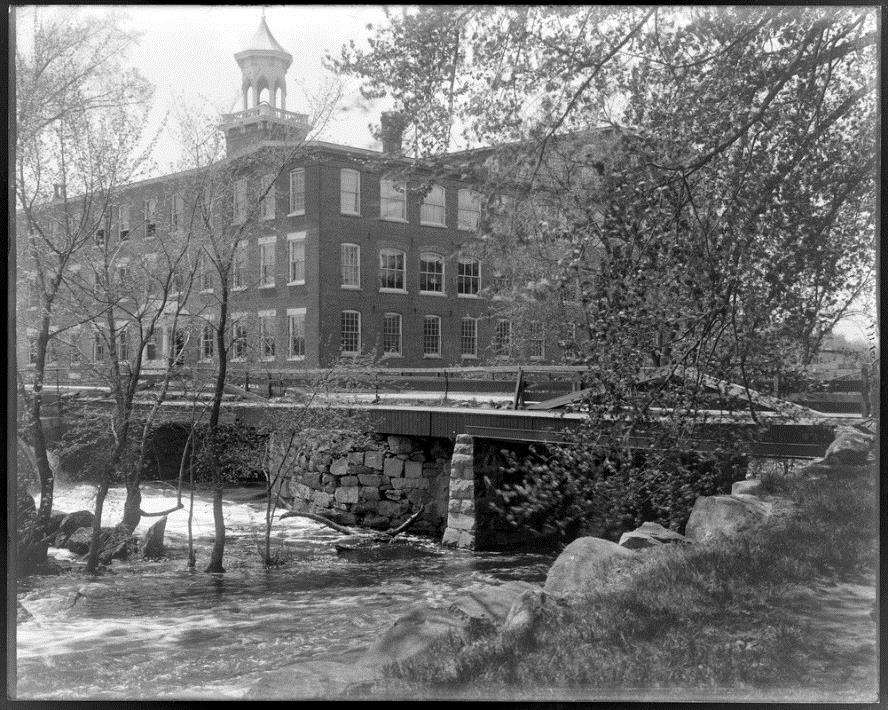
The Faulkner Street Bridge pictured in 1908.
The bridge had two heavy wooden trusses one extending from the west bank of the river to a pier of granite blocks about a third of the way across the river, and a similar truss extended from the east bank to a second pier. The section between the piers was supported with a solid, slightly convex, wall of stonework which diverted the water rushing spilling over the falls around the piers and under the east and west sections of the bridge.
The trio set to work immediately. They had been instructed to render a report at a special Town Meeting. The committee’s first step was to contact the Francis H. Kendall, the Middlesex County Commissioners’ engineer. He examined the bridge and found it to be in a dilapidated condition and unsafe for but the lightest of loads.
Without indecision the trio contacted J. R. Worcester of the engineering firm of J. R. Worcester and Company of Boston. He suggested that a reinforced concrete bridge would be the best option. Francis Kendall agreed. J. R. Worcester was well-respected within the engineering community. He was known for his expertise in steel and concrete construction and, as such, he was employed to survey the surroundings and make plans and specifications for a reinforced concrete bridge.
J. R. Worcester’s plan called for a two-span bridge, each span 48 feet in length. The overall width of 30 feet wide, provided for a 5-foot-wide sidewalk and 23-foot 2-inch in the clear travel lane. In the final analysis, the reinforced concrete arch bridge was to be 102 feet in length, and the site was suitable for construction of this type as the river bed provided a solid rock foundation.
The Committee sought bids from nine of the best concrete construction companies in the area. Four bids were received. The lowest bid came from the Hanscom Construction Company of Boston. This bid included not only the building of the bridge to Worcester’s specifications, but also the maintenance of a temporary bridge while the work was being done. These costs were projected at $6500.
For nearly two score years the Faulkner Mill storehouse at the north-east end of the bridge had obscured the view of the approaches to the bridge and necessitated a sharp curve in the roadway. The Faulkner Manufacturing Company agreed to remove the storehouse and rebuild it elsewhere on their property for an allowance of $1500, which was judged as slightly below cost. Removing the storehouse provided a more moderate curvature in the roadway and better sight lines to the bridge.
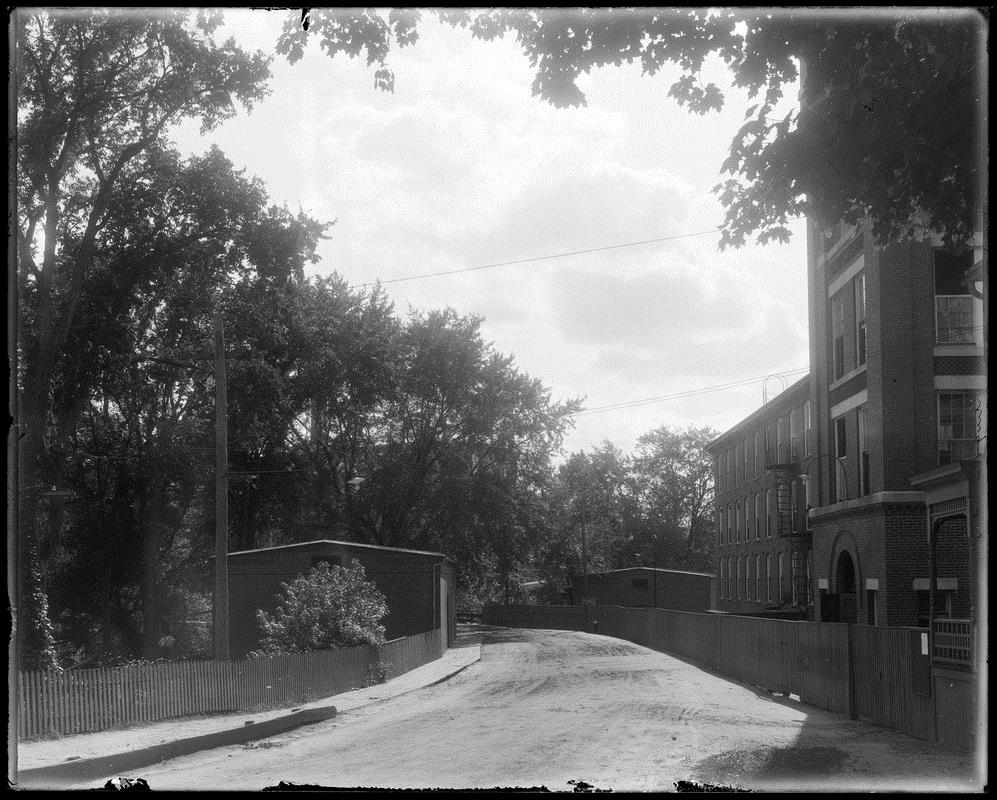
The Faulkner Manufacturing Company storehouse opposite the main mill complex which was removed when the new concrete bridge was built in 1910.
If the storehouse were removed the improvements to the roadway would cost an additional $400. Another expense, would be boxing the 10-inch water main, which would be laid through the bridge instead of the present truss system, to prevent it from freezing. In all the projected cost $8500.
A special Town Meeting was called on August 2, 1910. The Committee’s report was accepted. Although some in attendance objected to using tax dollars in conjunction with replacing the Faulkner Mill storehouse. On August 23, 1910, a motion that the Town borrow $9000, payable in nine equal installments was approved by Town Meeting 95-0. Town notes in the amount $1000 would be issued, the first $1000 note payable in one year, the second in two years and so on until the final $1000 note was paid in the ninth year. Interest on the notes was not to exceed 4 ½%. A second motion was voted in the affirmative that the committee that prepared the report manage the construction effort.
On August 8, 1910, the trio signed a contract for the sum of $5877, for building the reinforced concrete arched bridge over the Concord River below the dam at Faulkner Street, with the Hanscom Construction Company. Work on the project began almost immediately and was completed by the end of the year with the exception of the sidewalk and the macadamizing of the roadway. These were to be completed in the spring, as soon as the frost conditions would allow. The entire project was done under the watchful eye of the J. R. Worcester Company engineers.
The Committee to Oversee the Construction of the Faulkner Street Bridge rendered the following expense account in the 1911 Town Report:
| Hanscom Construction Company, on account of contract | $5477.00 |
| Hanscom Construction Company, moving and covering water pipe | 287.25 |
| J. R. Worcester Company, on account | 400.00 |
| Faulkner Manufacturing Company, moving and rebuilding storehouse | 1500.00 |
| Berry and Ferguson, 100 feet of split pipe | 68.00 |
| Builders Iron Foundry, castings | 9.00 |
| Water Works Department, moving pipe labor and materials | 119.72 |
| Street Department, labor on approaches | 116.08 |
| Total | $7977.05 |
Additional amounts expended in conjunction with the building of the cement bridge were reported in the 1912 Town Report. These expenses were probably incurred with the macadamizing of the bridge deck. It is not clear, however, if the sidewalk was completed at this time. The sidewalk, in place today, is comprised entirely of hot top including the curb and is not consistent with the style of the bridge, as is the chain link fence affixed to the top rail of the downriver side of the span. It is uncertain if the proposed sidewalk was completed until a much later date.
| Hanson (Hanscom) Construction Company | $461.95 |
| J. R. Worcester Company | 187.70 |
| C. B. Colburn Company | 45.82 |
| Talbot Mills | 3.24 |
| Total | $698.71 |
The bridge was opened without fan-fair. As the workmen were completing their final inspection of the bridge in late December of 1910, a man on his way to Lowell approached. The workmen waved him across nearly a century and decade ago.
The pictures that follow show the approaches to the bridge in 1910.

Approach to the bridge from the Talbot Mill side (West Bank) 1908

Wooden bridge deck from the downriver side in circa 1908
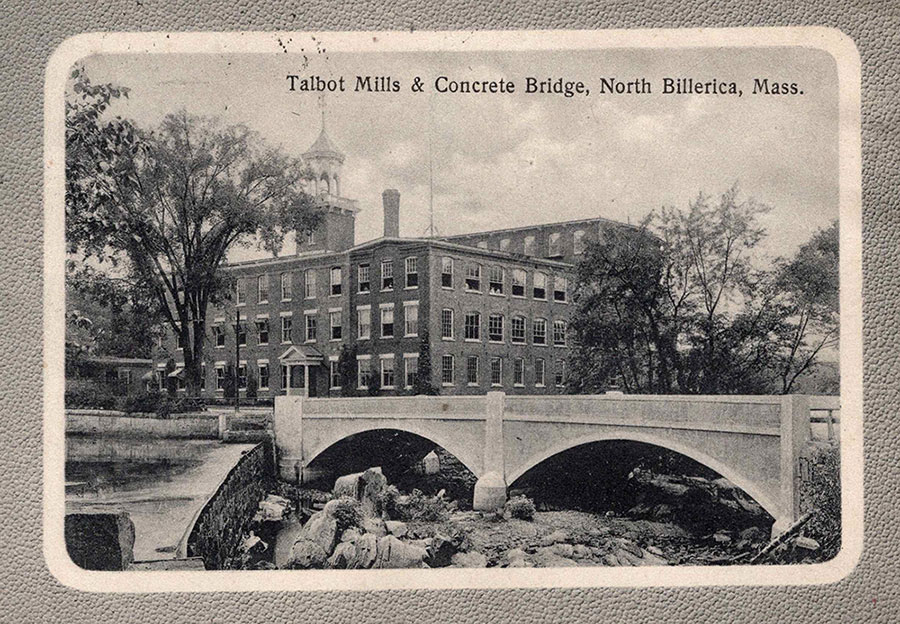
1910 Cement Bridge
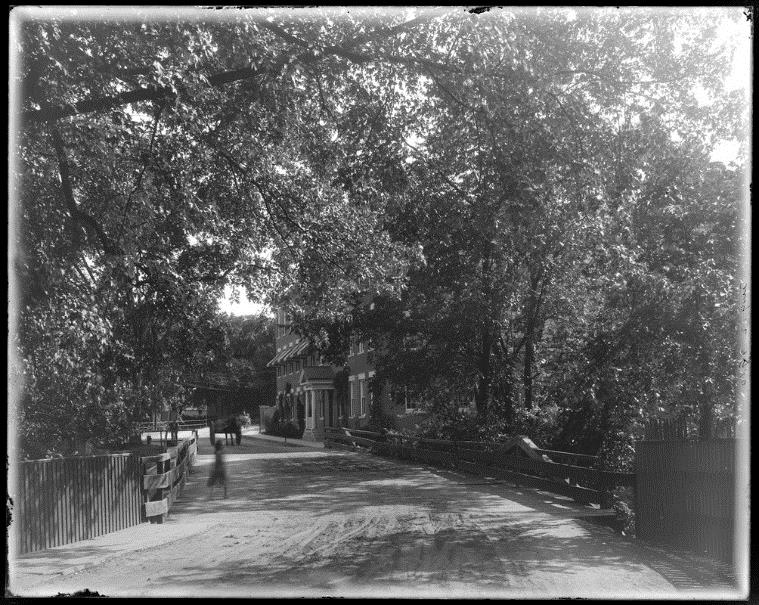
Approach to the bridge from the Faulkner Mill Side in 1908
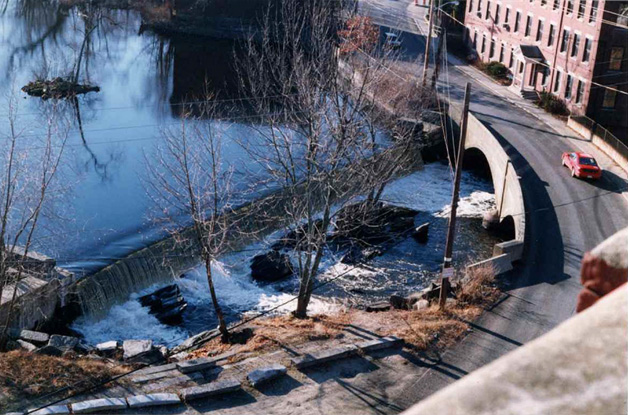
Picture of the cement bridge built in 1910.
The photograph was taken from the top of the Faulkner Mill tower by the author in 1998.
Bibliography:
The Annual Report of the Town of Billerica for the year ending February 28, 1910, The Lawler Printing Company, 29 Prescott Street, Lowell, MA: 1910.
The Annual Report of the Town of Billerica for the year ending February 28, 1911, The Lawler Printing Company, 29 Prescott Street, Lowell, MA: 1911.
The Annual Report of the Town of Billerica for the year ending February 28, 1912, Courier Citizen Company, 67 Middle Street, Lowell, MA: 1912.
Billerica, Massachusetts: History Captured on Glass, Billerica Public Library, Digital Commonwealth, Massachusetts Collections Online.
NB: MassDot inspected the bridge in the picture on September 25, 2019. Selected statistic from the inspection are contained in the following list.
Structural Material: Concrete
Structural Type: Arch-Deck
Structure Length: 32.3 meters
Bridge Owner: Billerica, MA
Structural Deficient: No
Posted: For Load
Deck Condition: N
Superstructure Condition: 5
Substructure Condition: 6
Deck Area: 3,129.06866222 square meters
The Smallpox Cemetery: A History (Part #1)
by Alec Ingraham
Courtesy Billerica Historical Society / Maria Seminatore |
Preface: If you see the Pond Street Bridge you’ve gone too far!
After many decades of research, I finally came to the realization that this lonely once remote, oft forgotten grave site required consideration and above all protection from encroachment. There was concern that the recently completed solar farms on High Street and Pond Street might overwhelm the small cemetery. Many historically minded citizens, as the photovoltaic cells were being installed, wandered along the railroad tracks hoping to find the lonely cemetery undisturbed. Although not recommended, others took a shorter route through “someone’s” side yard. “If you can see the Pond Street Bridge, you’ve gone too far!” was their mantra.
The tiny cemetery, where the victims of the Town’s 1811 smallpox epidemic are buried, is unique in Billerica. Townspeople who succumbed to smallpox were typically interred in one of the Town’s main cemeteries. Although it has no street address, as far as I know, this small gravesite is located approximately halfway between the High Street and Pond Street overpasses which span the MBTA’s Boston/Lowell commuter rail line. The single grave stone marking the site stands about 150 feet south of the railroad tracks on a lightly wooded rise.
The MBTA’s construction of a new dispatch center at Iron Horse Park was unexpected and again calls went out to make certain that the gravesite was not compromised. Although the cemetery is visited frequently on nature walks along the Middlesex Canal, the remnants of which pass near-by, more oversite is required.
I hope this brief article will stimulate interest in preserving the cemetery and inspire others to do further enquiry on this “smallpox epidemic” which occurred in Billerica over two centuries ago. There are many unanswered questions which beg additional research. What was the source of the epidemic? How did Sarah Hodgman and Eleazer Framer become involved? Why were the victims buried in such a remote area? These questions and others involving the background of the people who perished and those who survived require additional examination. I have enjoyed the challenges of the research and I sincerely hope it leads to a productive end.
The Introduction
Since the mid 1950’s I have been aware of the existence of the smallpox cemetery in North Billerica. During my years as a Cub Scout my den would visit the site each year. Keeping a watchful eye out for locomotives, we would depart from the High Street railroad overpass, heading toward Pond Street, frequently exploring the area adjacent to the southbound Boston and Maine Railroad’s (now the MBTA) mainline from Lowell to Boston. The passing of a freight train always heightened our sense of adventure. The grave site, however, was simply a destination for a hike. I am sure my fellow comrades shared my ignorance, at that time, concerning the dread caused by an outbreak of smallpox.
Over the years, I have maintained an interest in learning more about the history of this smallpox cemetery. After many decades of contemplation, I decided it was time to summarize my many pages of notes. As I took pen in hand, I was reminded of the time I raced out of the Medical Associates Office on Prescott Street in Lowell in hopes of escaping my smallpox vaccination. Fortunately, I was a young lad and not fast enough to escape.
Smallpox
Smallpox was an infectious disease caused by one of two virus variants, Variola major and Variola minor. … The risk of death following contracting the disease was about 30% with higher rates among babies. Often those who survive have extensive scarring of their skin and some are left blind.
The initial symptoms of the disease include fever and vomiting. This is then followed by formation of sores in the mouth and a skin rash. Over a number of days the skin rash turns into characteristic fluid filled bumps with a dent in the center. The bumps then scab over and fall off leaving scars. …
The origin of smallpox is unknown. The earliest evidence of the disease dates back to the 3rd century B.C. in Egyptian mummies. The disease historically occurred in outbreaks. … (Wikipedia “Smallpox”) Also referred to as Pox, Speckled Monster, and Red Plague, the World Health Organization estimates that small pox has caused in excess of 500 million deaths, worldwide, over the centuries.
Smallpox is spread though inhalation of the air born virus or through the use of contaminated objects. The incubation period (from exposure to the development of symptoms) is 12 days to three weeks. Once symptoms develop it takes upward to four weeks for the Variola virus to run its course. If death occurs, it typically happens between the 10th and 16th day.
The August, 1811 smallpox outbreak in Billerica would appear to have followed the typical pattern. According to John Farmer’s 1816 History of Billerica, five of the fifteen people succumbed to the disease or 33 1/3% and it was spread among the family members and friends who somehow, unfortunately, came in contact with the virus through association.
The Legend
“A tale of heroism never before published but handed down by word of mouth since the death of the heroine more than a century ago has come to light … The heroine was Sarah Hodgman, a typical New England woman of the type that was born during the stirring days of the war of the revolution and who came from kind stock part of whose creed is self-sacrifice. According to the tale as it was told by some of the older Billerica residents, Asa Frost with his two sons, Asa Frost, Jr. and Levi Frost lived in a house on Pond Street near the Tewksbury line. With them were staying Samuel T. Batcheller and Eleazer Farmer. All that remains of the house is a cellar hole since overgrown with weeds.”
“During the summer of 1811 an epidemic of small pox broke out and all the members of Frost family became infected together with their two guests. The dread of the loathsome disease was so great at the time that there was nobody who dared go near the house and the inmates who were slowly dying in agony for want of a kindly hand to bring a glass of water to appease a burning thirst. Sarah Hodgman heard of their desperate situation and, regardless of the pleadings of her friends, she went into the Frost home and cared for the victims. About a week later, after she had established herself there it was noticed one morning that the customary smoke did not curl up from the chimney and that a death-like stillness was in the atmosphere of the Frost home. Finally, some of the neighbors summoned the courage to call at the house and every one of the inmates including Sarah Hodgman was dead.
The bodies were all buried together in a little mound a half-mile away from the nearest house in a densely wooded section … ” This information is an excerpt from “Lonely Grave Recalls Tale of Woman’s Heroism” published in the May 5, 1912 edition of The Sunday Boston Herald.
As is the case with many legends, the facts are often embellished to make the story more interesting, but there are also some elements of truth contained therein. The story, however, was picked up and published by newspapers in the Mid-West and as far away as San Francisco.
Another Viewpoint
“In the summer of 1811 small pox made its appearance in the north part of town. The cause from which it originated, seems to be involved in mystery. It commenced in the family of Asa Frost, and had communicated to several others before the disorder was known. The alarm produced in the neighborhood, when the disorder was ascertained to be small pox, can better be conceived than described. The consternation became general and extended through the town and others in the vicinity, till a period was put to it by general vaccination, which was effected in a few weeks. Of the fifteen who had small pox five persons fell victim to its malignity.” This description of the smallpox epidemic is far less dramatic than that contained in The Sunday Herald and can be found in An Historical Memoir of Billerica Containing Notices of the Principal Events, in the Civil and Ecclesiastical Affairs of the Town from its First Settlement to 1816 by John Farmer: Published by Request: Amherst, N.H. and printed by R. Boylston, 1816.
A Third Opinion
“In 1811, there was an epidemic of smallpox with a number of deaths. Several of these were buried in a common gave and years later erected a monument to their memory. The grave was a little gravel mound in the midst of a vast swamp. I have been told that they were buried at midnight. Here again the concept of uncleanness may have been a factor, although most smallpox victims were buried in ordinary cemeteries.” (This information was extracted from an unpublished paper entitled: “Gravestones: A Study of the South Cemetery” by Dr. A. Warren Stearns.) The manuscript provides additional evidence. The term “unclean” used in this context is chiefly Biblical in nature meaning “having a moral or physical blemish so as to make impure according to the laws especially the dietary or ceremonial laws.” It might simply have been that traffic on the nearby Middlesex Canal would be unlikely at the witching hour. Boats and raft were not allowed to pass through any lock after dark, 10 o’clock at the latest on bright moonlit summer nights. (Middlesex Canal By-laws)
A Fourth Conversation
“There was a discussion about the Small Pox Cemetery in North Billerica. Helen (Knight) said the E. P. A. was having a meeting with Paul Talbot (Town Administrator) on Tuesday, January 21, 1986, at the George Lewis Building. The meeting was about Iron Horse Park and the Superfund Site in Billerica. She wanted to make sure they knew about the Smallpox Cemetery, which is located near this property, and that it would be preserved. Margaret (Ingraham) has a grave rubbing of the stone at the Smallpox Cemetery which listed the following on the stone: Asa Frost, Asa Frost, Jr., Lewis (sic. Levi) Frost, Elezjar (Eleazar) Farmer, Sarah Hodgman, Samuel T. Batchelder (Batcheller). It said they were buried who died of the Small Pox and was dated August 1811. She said Sarah Hodgman might have been a neighbor who went into to take care of the Frost family when they were stricken. Dr. Stearns said the cemetery would be under the jurisdiction of the Cemetery Commission. Helen said at one time there were small stones on the graves, right near the railroad track. You could see them from the train. Margaret said the big stone has faced in two or three different directions over the years….{Dr. Stearns}When the victims died they were carried across the fields in the night and were buried far from any habitation. Twenty-four years later the railroad had to be laid out in a great curve in order to bypass the cemetery. The monument was erected in 1835.” These unedited minutes of the January 15, 1986 meeting of the Billerica Historical Commission provide some useful information.
The Catalyst
On June 1, 2005, The Lowell Sun included an article by reporter Matt Murphy, entitled “A mystery of historical proportions: Obscure grave marker in Billerica denotes family’s death from smallpox. He writes: “Buried in the woods off the commuter- rail tracks in North Billerica, a single weather beaten tombstone stands alone in a clearing with a bouquet of flowers resting at its foot.
The 6-foot tall monument marks the final resting place of a local family that died almost 200 years ago from the smallpox virus.
But despite the Billerica Public Library’s best efforts to explain the origins of this hidden, historical marker, there are still as many questions as there are answers.”
Smallpox at the Time in Massachusetts
In 1721, an inoculation to slow the development of smallpox was introduced in Boston. It was commonly referred to as variolation, which involved infecting a healthy patient with the disease from an individual who had developed what was referred to a less virile form of smallpox. Variolation was met with much controversy, but became more established as time progressed, and some successes were witnessed. In 2% to 3% of the instances of variolation, however, the patient would die of smallpox, or infect others with the disease, or develop tuberculous or another infectious ailment.
To address the flaws in the process, the Legislature, in 1776, passed an act which allowed counties in the state to erect inoculation hospitals. Variolation was forbidden except at such hospitals. In the instance of an outbreak of smallpox such a hospital must be opened and all that are afflicted must be moved there, unless unsafe to do so. Householders not giving notice of an outbreak would be fined between 10 and 30 pounds.
Recognizing that variolation remained a danger, the Legislature redrafted the act in 1792. If an outbreak of smallpox occurred all infected persons must be removed to a hospital devoted to their care. Individuals receiving an inoculation elsewhere than in a licensed hospital would be fined $200 and must display a red flag to warn travelers. Householders and physicians who neglected to warn others of a smallpox outbreak would be fined $100.
By 1797, another revision was made allowing that, if for any reason a person afflicted with smallpox could not be moved to a hospital, provisions must be made for him in the house in which he might be. The Board of Health, in many towns at the time the Selectmen, must remove people from the vicinity and turn back travelers. If not obeyed a fine of $100 was levied. The right to seize luggage or break into the shop or home of a stricken person was granted to the Board of Health as well. If asked, those refusing aid to a smallpox victim could be fined $10.
Since 1792, there had been no major smallpox epidemics and between 1811 and 1837 there were but 39 deaths from smallpox in Boston. In 1837, twenty prominent persons signed a petition to repeal the acts of 1792 and 1796. (“The Story of Smallpox in Massachusetts”, Annual Oration in 1932 by Samuel Bayard Woodward, M.D. before the Massachusetts Medical Society, masmed.org November 14, 2016)
In the late 1790’s, Dr. Edward Jenner, an English physician was experimenting with a vaccine which he made from cow pox germs. After much public resistance to his theory that those inoculated with the vaccine would get a mild case of cow pox and become immune to small- pox, he was finally able to convince the British Parliament, in 1802, that the vaccine was a safe preventative for the disease. Despite medical advances sufficient to develop this vaccine, there remained at the time, even among physicians, much suspicion and hesitation concerning its use. (Wikipedia)
MISCELLANY
Back Issues - More than 50 years of back issues of Towpath Topics, together with an index to the content of all issues, are also available from our website http://middlesexcanal.org/towpath. These are an excellent resource for anyone who wishes to learn more about the canal and should be particularly useful for historic researchers.
Estate Planning - To those of you who are making your final arrangements, please remember the Middlesex Canal Association. Your help is vital to our future. Thank you for considering us.
Membership and Dues – There are two categories of membership: Proprietor (voting) and Member (non-voting). Annual dues for “Proprietor” are $25 and for “Member” just $10. Additional contributions are always welcome and gratefully accepted. If interested in becoming a “Proprietor” or a “Member” of the MCA, please mail membership checks to Neil Devins, 28 Burlington Avenue, Wilmington, MA 01887.
Museum & Reardon Room Rental - The facility is available at very reasonable rates for private affairs, and for non-profit organizations to hold meetings. The conference room holds up to 60 people and includes access to a kitchen and restrooms. For details and additional information please contact the museum at 978-670-2740.
Museum Shop - Looking for that perfect gift for a Middlesex Canal aficionado? Don’t forget to check out the inventory of canal related books, maps, and other items of general interest available at the museum shop. The store is open weekends from noon to 4:00pm except during holidays.
Nameplate - Excerpt from an acrylic reproduction of a watercolor painted by Jabez Ward Barton, ca. 1825, entitled “View from William Rogers House”. Shown, looking west, may be the packet boat George Washington being towed across the Concord River from the Floating Towpath at North Billerica.
Web Site – The URL for the Middlesex Canal Association’s web site is www.middlesexcanal.org. Our webmaster, Robert Winters, keeps the site up to date. Events, articles and other information will sometimes appear there before it can get to you through Towpath Topics. Please check the site from time to time for new entries.
The first issue of the Middlesex Canal Association newsletter was published in October, 1963. Originally named “Canal News”, the first issue featured a contest to name the newsletter. A year later, the newsletter was renamed “Towpath Topics.”

Excerpt from an August 1818, drawing (artist unknown) of the steam towboat
Merrimack crossing the original (pre-1829) Medford Aqueduct,
probably on its way to service on the Merrimack River.
Towpath Topics is edited and published by Debra Fox, Alec Ingraham, and Robert Winters.
Corrections, contributions and ideas for future issues are always welcome.